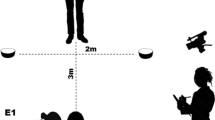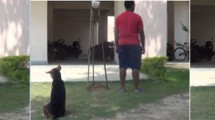Abstract
The study raises the question of whether guide dogs and pet dogs are expected to differ in response to cues of referential communication given by their owners; especially since guide dogs grow up among sighted humans, and while living with their blind owners, they still have interactions with several sighted people. Guide dogs and pet dogs were required to respond to point, point and gaze, gaze and control cues of referential communication given by their owners. Results indicate that the two groups of dogs do not differ from each other, revealing that the visual status of the owner is not a factor in the use of cues of referential communication. Both groups of dogs have higher frequencies of performance and faster latencies for the point and the point and gaze cues as compared to gaze cue only. However, responses to control cues are below chance performance for the guide dogs, whereas the pet dogs perform at chance. The below chance performance of the guide dogs may be explained by a tendency among them to go and stand by the owner. The study indicates that both groups of dogs respond similarly in normal daily dyadic interaction with their owners and the lower comprehension of the human gaze may be a less salient cue among dogs in comparison to the pointing gesture.



Similar content being viewed by others
References
Agnetta B, Hare B, Tomasello M (2000) Cues to food locations that domestic dogs (Canis familiaris) of different ages do and do not use. Anim Cogn 3:107–112
Bering JM (2004) A critical review of the ‘enculturation hypothesis’: the effects of human rearing on great ape social cognition. Anim Cogn 7:201–213
Bräuer J, Call J, Tomasello M (2004) Visual perspective-taking in dogs (Canis familiaris) in the presence of barriers. Appl Anim Behav Sci 88:299–317
Bräuer J, Kaminski J, Riedel J, Call J, Tomasello M (2006) Making inferences about the location of hidden food: social dog–causal ape. J Comp Psychol 120:38–47
Byrne RW (2003) Animal communication. What makes a dog able to understand its masters. Curr Biol 13:R347–R348
Call J, Tomasello M (1996) The effect of humans on the cognitive development of apes. In: Russon AE, Bard KA, Parker ST (eds) Reaching into thought: the minds of the great apes. Cambridge University Press, Cambridge, pp 371–403
Call J, Tomasello M (2004) Social cognition. In: Maestripieri D (ed) Primate psychology. Harvard University Press, USA, pp 234–253
Call J, Agnetta B, Tomasello M (2000) Cues that chimpanzees do and do not use to find hidden objects. Anim Cogn 3:23–34
Call J, Bräuer J, Kaminski J, Tomasello M (2003) Domestic dogs are sensitive to the attentional state of humans. J Comp Psychol 117:257–263
Cooper JJ, Aston C, Bishop S, West R, Mills DS, Young RJ (2003) Clever hounds: social cognition in the domestic dog (Canis familiaris). App Anim Behav Sci 81:229–244
Csányi V (2000) The ‘human behaviour complex’ and the compulsion of communication: key factors in human evolution. Semiotica 128:45–60
Dunn OJ (1964) Multiple comparisons using ranks. Technometrics 6:241–252
Gácsi M, Miklósi Á, Varga O, Topál J, Csányi V (2004) Are readers of our face readers of our minds? Dogs (Canis familiaris) show situation-dependent recognition of human’s attention. Anim Cogn 7:144–153
Gaunet F (2008) How do guide dogs and pet dogs (Canis familiaris) ask their owners for food? Anim Cogn 11(3):475–483
Goldin Meadow S (1999) The role of gesture in communication and thinking. Trends Cogn Sci 3:419–429
Gomez DC (2005) Species comparative studies and cognitive development. Trends Cogn Sci 9:118–125
Hare B (2001) Can competitive paradigms increase the validity of experiments on primate social cognition? Anim Cogn 4:269–280
Hare B, Tomasello M (1999) Domestic dogs (Canis Familiaris) use human and conspecific social cues to locate hidden food. J Comp Psychol 113:173–177
Hare B, Tomasello M (2004) Chimpanzees are more skilful in competitive than cooperative cognitive tasks. Anim Behav 68:571–581
Hare B, Tomasello M (2005) Human-like social skills in dogs? Trends Cogn Sci 9:439–444
Hare B, Call J, Tomasello M (1998) Communication and food location between human and dogs (Canis familiaris). Evol Commun 2:137–159
Hare B, Brown M, Williamson C, Tomasello M (2002) The domestication of social cognition in dogs. Science 298:1634–1636
Hare B, Plyusnina I, Ignacio N, Schepina O, Stepika A, Wrangham R, Trut L (2005) Social cognitive evolution in captive foxed is a correlated by product of experimental domestication. Curr Biol 15:226–230
Heyes CM (1994) Cues, convergence and curmudgeon: a reply to Povinelli. Anim Behav 48:242–244
Itakura S (2004) Gaze following and joint visual attention in nonhuman animals. Jpn Psychol Res 46:216–226
Kerepesi A, Jonsson GK, Miklósi Á, Topál J, Csányi V, Magnusson MS (2005) Detection of long-term temporal patterns in dog-human interaction. J Behav Processes 70:69–79
Maros K, Gácsi M, Miklósi Á (2008) Comprehension of human pointing gestures in horses (Equus caballus). Anim Cogn 11:3 467–466
McKinley J, Sambrook TD (2000) Use of human given cues by domestic dogs (Canis familiaris) and horses (Equus caballus). Anim Cogn 3:13–22
Miklósi Á, Soproni K (2006) A comparative analysis of animals’ understanding of the human pointing gesture. Anim Cogn 9:81–93
Miklósi Á, Polgárdi R, Topál J, Csányi V (1998) Use of experimenter given cues in dogs. Anim Cogn 1:113–121
Miklósi Á, Kubinyi E, Topál J, Gasci M, Viranyi Z, Csányi V (2003) A simple reason for a big difference: wolves do not look back at humans but dogs do. Curr Biol 13:763–766
Miklósi Á, Topál J, Csányi V (2004) Comparative social cognition: what can dogs teach us? Anim Behav 67:995–1004
Miklósi Á, Pongrácz P, Lakatos G, Topál J, Csányi V (2005) A comparative study of dog-human and cat-human interactions in communicative contexts. J Comp Psychol 119:179–186
Naderi A, Miklósi Á, Dóka A, Csányi V (2001) Co-operative interactions between blind persons and their dogs. Appl Anim Behav Sci 74:59–80
Povinelli DJ, Reaux JE, Bierschwale DT, Allain AD, Simon BB (1997) Exploitation of pointing as a referential gesture in young children, but not adolescent chimpanzees. Cogn Dev 12:423–461
Scheumann M, Call J (2004) The use of experimenter given cues by South African fur seals (Arctocephalus pusillus). Anim Cogn 7:224–231
Shapiro AD, Janik VM, Slater PJB (2003) Gray seal (Halichoerus grypus) pup responses to experimental-given pointing and directional cues. J Comp Psychol 117:355–362
Siegel S, Castellan JN Jr (1988) Non parametric statistics for the behavioural sciences, 2nd edn. McGraw-Hill, New York
Soproni K, Miklósi Á, Topál J, Csányi V (2001) Comprehension of human communicative signs in pet dogs (Canis familiaris). J Comp Psychol 115:122–126
Soproni K, Miklósi Á, Topál J, Csányi V (2002) Dogs’ responsiveness to human pointing gestures. J Comp Psychol 116:27–34
Tomasello M, Call J (2004) The role of humans in the cognitive development of apes revisted. Anim Cogn 7:213–215
Tomasello M, Call J, Gluckman A (1997a) Comprehension of novel communicative signs by apes and human children. Child Dev 68:1067–1080
Tomasello M, Call J, Hare B (1997b) Five primate species follow the visual gaze of conspecifics. Anim Behav 55:1063–1069
Viranyi Z, Topál J, Gácsi M, Miklósi Á, Csányi V (2004) Dogs respond appropriately to cues of humans’ attentional focus. Behav Processes 66:161–172
Virányi Z, Gácsi M, Kubinyi E, Topál J, Belényi B, Ujfalussy D, Miklósi Á (2008) Comprehension of human pointing gestures in young human-reared wolves (Canis lupus) and dogs (Canis familiaris). Anim Cogn 11(3):373–387
Acknowledgments
This work was supported by INSERM NORD-SUD France and conducted at the Laboratoire Eco-Anthropologie et Ethnobiologie, Muséum National Histoire Naturelle, Paris, France in an Indo-French research collaboration. We are especially grateful to the guide and pet dog-owner dyads for their interest and cooperation and to D. Sulinski for her assistance in the experiment and both P. Piwowar and D. Sulinski for their help in checking the data. The experiments complied with the current French laws governing animal research.
Author information
Authors and Affiliations
Corresponding author
Rights and permissions
About this article
Cite this article
Ittyerah, M., Gaunet, F. The response of guide dogs and pet dogs (Canis Familiaris) to cues of human referential communication (pointing and gaze). Anim Cogn 12, 257–265 (2009). https://doi.org/10.1007/s10071-008-0188-6
Received:
Revised:
Accepted:
Published:
Issue Date:
DOI: https://doi.org/10.1007/s10071-008-0188-6




